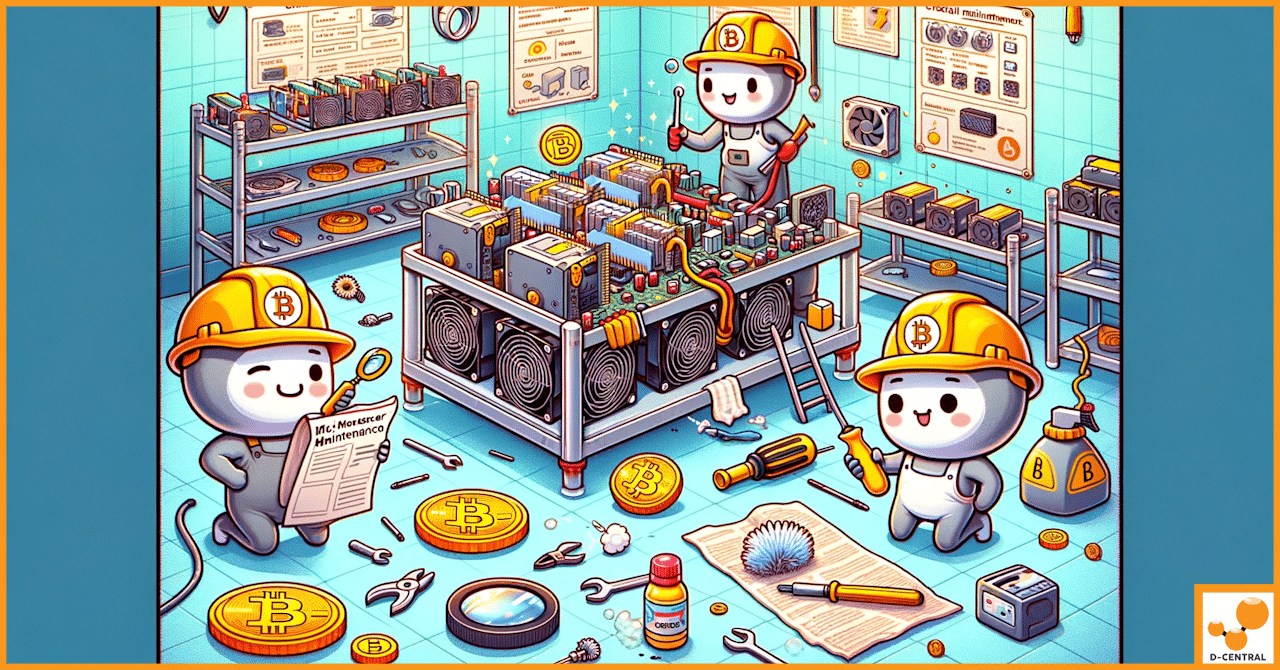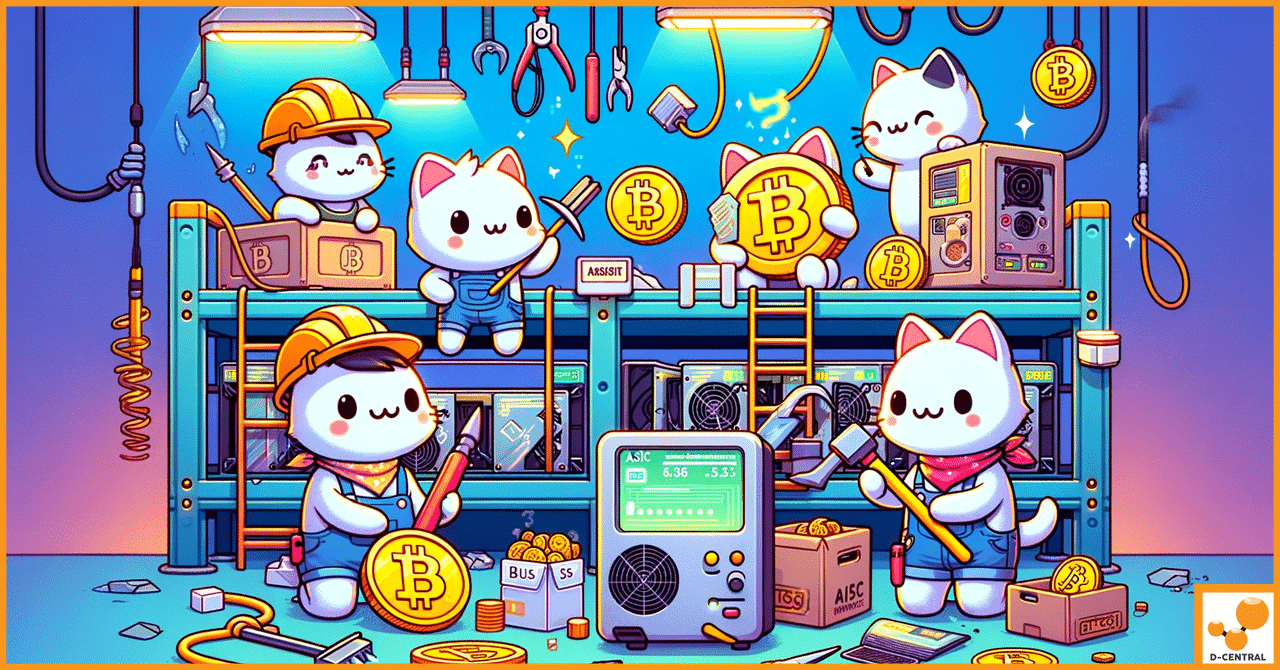
Bitcoin Miner Maintenance: Prolonging the Life of Your Hardware
In the dynamic world of cryptocurrency, Bitcoin mining stands as a cornerstone activity, driving the decentralized network that supports the
4479 Desserte Nord Autoroute 440, Laval, QC H7P 6E2

In the dynamic world of cryptocurrency mining, Application-Specific Integrated Circuit (ASIC) miners have emerged as pivotal tools for anyone serious about mining efficiently and profitably. Unlike their predecessors—CPUs, GPUs, and FPGAs—ASIC miners are designed with a singular purpose: to mine cryptocurrency at unparalleled speeds while consuming significantly less power. This specialization has positioned ASIC miners at the heart of the cryptocurrency mining industry, enabling miners to unlock new levels of performance and profitability.
However, the cutting-edge capabilities of ASIC miners come with their own set of challenges, particularly in terms of maintenance and lifecycle management. The concept of hardware lifecycle management becomes crucial in this context, serving as a comprehensive approach to managing these sophisticated devices from procurement to decommissioning. Effective lifecycle management ensures that ASIC miners maintain their peak performance throughout their operational life, thereby maximizing the return on investment for miners.
The importance of hardware lifecycle management for ASIC miners cannot be overstated. It encompasses a range of practices—from regular maintenance and firmware updates to strategic upgrades and eventual retirement—that together ensure the longevity, efficiency, and profitability of mining operations. In an industry where technological advancements occur at a breakneck pace, the ability to adeptly manage the lifecycle of ASIC miners can be the difference between thriving and merely surviving. Thus, understanding and implementing robust hardware lifecycle management practices is essential for anyone looking to succeed in the competitive realm of cryptocurrency mining.
Application-Specific Integrated Circuit (ASIC) miners represent a quantum leap in cryptocurrency mining technology. Unlike general-purpose hardware such as CPUs (Central Processing Units) and GPUs (Graphics Processing Units), ASIC miners are designed with a singular focus: to mine specific cryptocurrencies as efficiently as possible. This specialization allows ASIC miners to outperform their general-purpose counterparts in both speed and energy efficiency, making them the gold standard in the mining industry.
ASIC miners are highly specialized hardware devices engineered to perform the cryptographic calculations required for mining a particular cryptocurrency. The “application-specific” part of their name underscores their design philosophy; each ASIC miner is tailored to mine a specific blockchain algorithm. This contrasts sharply with CPUs and GPUs, which are built to handle a wide range of computing tasks but lack the efficiency of ASICs in any single task. FPGAs (Field-Programmable Gate Arrays), which fall somewhere between general-purpose hardware and ASICs, offer a degree of specialization but still cannot match the efficiency and performance of ASIC miners.
The key difference between ASIC miners and other forms of mining hardware lies in their efficiency and performance. ASIC miners are optimized to execute the specific hashing algorithm of a particular cryptocurrency, which allows them to achieve unparalleled hashing rates while minimizing power consumption. This optimization results in a significant reduction in operational costs and a substantial increase in potential profits, especially in large-scale mining operations where efficiency scales dramatically.
The advent of ASIC miners has fundamentally transformed the landscape of cryptocurrency mining. Their efficiency and speed mean that blockchains that can be mined using ASICs have become increasingly centralized around these powerful devices, pushing out less efficient miners and consolidating mining power in the hands of those who can afford the best technology.
For cryptocurrencies that are ASIC-resistant, other forms of hardware like GPUs remain relevant. However, for those that are not, ASIC miners have become indispensable for anyone looking to mine competitively. They not only maximize profitability through reduced electricity consumption but also increase the chances of successfully mining blocks and receiving block rewards.
In essence, ASIC miners have set a new standard in cryptocurrency mining, enabling miners to achieve greater efficiency and profitability. Their role in the industry underscores the importance of continuous innovation and adaptation in mining technology, as well as the need for effective hardware lifecycle management to sustain long-term mining success.
In the rapidly evolving domain of cryptocurrency mining, the deployment of Application-Specific Integrated Circuit (ASIC) miners has become a game-changer, significantly enhancing the efficiency and profitability of mining operations. However, the high-performance capabilities of ASIC miners come with their own set of challenges, particularly in terms of maintenance, operational longevity, and overall lifecycle management. Understanding and implementing effective hardware lifecycle management is crucial for maximizing the operational lifespan and efficiency of ASIC miners, ensuring that these investments continue to yield optimal returns over time.
Hardware lifecycle management (HLCM) refers to the comprehensive process of managing the entire lifespan of a hardware asset, from its initial acquisition and deployment to its eventual retirement and disposal. This process encompasses several critical stages, including procurement, deployment, maintenance, monitoring, and decommissioning. For ASIC miners, which are at the forefront of mining technology, HLCM is particularly relevant due to their specialized nature and the significant investment they represent.
Effective lifecycle management for ASIC miners involves proactive maintenance strategies, regular performance evaluations, timely upgrades, and efficient decommissioning practices. By adopting a holistic approach to managing these devices, miners can ensure that their ASIC hardware remains in peak operating condition, thereby maximizing efficiency and prolonging its useful life.
The importance of hardware lifecycle management for ASIC miners cannot be overstated. It is a critical component of successful and profitable mining operations, ensuring that ASIC miners maintain their efficiency and operational longevity. By adopting comprehensive lifecycle management practices, miners can safeguard their investments, optimize their operations, and navigate the complexities of the cryptocurrency mining landscape with greater confidence and strategic insight.
Managing the lifecycle of ASIC miners is a critical aspect of running a profitable cryptocurrency mining operation. From the initial purchase to eventual decommissioning, each stage of the lifecycle requires careful consideration and strategic planning. Here’s a comprehensive look at the key stages of ASIC miner lifecycle management:
Best Practices for Selecting and Acquiring ASIC Miners:
Guidelines for Setting Up ASIC Miners:
Detailed Strategies for Regular Maintenance:
When and How to Upgrade ASIC Miners:
Responsible Disposal or Repurposing of ASIC Miners:
By meticulously managing each stage of the ASIC miner lifecycle, miners can optimize their operations for maximum efficiency, profitability, and sustainability.
In the competitive world of cryptocurrency mining, maintaining peak performance of ASIC miners is crucial. Beyond routine maintenance, advanced techniques and custom modifications can further enhance the efficiency, performance, and longevity of these devices. Additionally, leveraging professional ASIC repair services plays a pivotal role in sustaining mining operations over the long term.
Noise Reduction:
Energy Efficiency Improvements:
Cooling System Upgrades:
Extending Hardware Lifespan:
Maintaining Peak Performance:
Customization and Optimization:
Advanced maintenance techniques and custom modifications can significantly enhance the performance and efficiency of ASIC miners, while professional ASIC repair services play a crucial role in maintaining and extending the life of mining hardware. Together, these strategies ensure that mining operations can continue to thrive in the fast-paced and ever-evolving landscape of cryptocurrency mining.
Proper maintenance of ASIC miners is not just a technical necessity; it’s an economic strategy that significantly influences the total cost of ownership and the profitability of cryptocurrency mining operations. Through diligent maintenance practices, miners can ensure their hardware operates efficiently, remains competitive for longer, and yields a higher return on investment. This section delves into the economic implications of effective ASIC maintenance and highlights real-world examples to illustrate its impact.
The total cost of ownership (TCO) for ASIC miners encompasses the initial purchase price, operational expenses (such as electricity and cooling), and maintenance costs. Effective maintenance can dramatically affect the latter two components:
The profitability of ASIC mining operations hinges on the delicate balance between operational costs and the value of mined cryptocurrencies. Maintenance plays a crucial role in this equation:
Effective ASIC maintenance is a critical component of successful mining operations, with direct implications for both the total cost of ownership and overall profitability. By adopting strategic maintenance practices, miners can not only ensure the longevity and efficiency of their hardware but also secure a competitive edge in the ever-evolving landscape of cryptocurrency mining.
The journey through the intricacies of ASIC maintenance and its pivotal role in hardware lifecycle management underscores a fundamental truth in the realm of cryptocurrency mining: diligent, proactive maintenance is not merely a technical requirement but a strategic imperative. The efficiency, longevity, and profitability of ASIC miners hinge on a comprehensive approach to maintenance, one that extends beyond simple upkeep to encompass a holistic view of the miner’s lifecycle from procurement to decommissioning.
The importance of ASIC maintenance within the context of hardware lifecycle management cannot be overstated. Effective maintenance practices serve as the backbone of operational efficiency, ensuring that miners operate at peak performance, consume energy judiciously, and remain competitive over an extended period. This, in turn, has a direct impact on the total cost of ownership and the overall profitability of mining operations, making maintenance a key factor in the economic equation of cryptocurrency mining.
Encouraging proactive maintenance strategies is more than just advice; it’s a call to action for miners who seek to maximize the efficiency and lifespan of their ASIC miners. Implementing the outlined maintenance strategies—ranging from routine cleaning and cooling system checks to firmware updates and energy efficiency optimizations—can significantly enhance the performance and durability of mining hardware. Moreover, these practices can mitigate the risk of unplanned downtime, ensuring a steady and reliable mining operation.
For those looking to elevate their mining operations, leveraging professional ASIC maintenance and repair services offered by leading providers like D-Central Technologies represents a strategic advantage. With expertise in advanced maintenance techniques, custom modifications, and comprehensive repair services, D-Central Technologies stands as a beacon for miners seeking to optimize their hardware’s performance and longevity. By partnering with such professionals, miners can benefit from specialized knowledge and services tailored to the unique demands of cryptocurrency mining.
In conclusion, the path to sustained success in cryptocurrency mining is paved with meticulous attention to ASIC maintenance. By embracing proactive maintenance strategies and seeking the support of professional services, miners can ensure that their operations not only survive but thrive in the competitive landscape of cryptocurrency mining. Let the commitment to excellence in ASIC maintenance be the cornerstone of your mining strategy, and watch as it transforms the efficiency, longevity, and profitability of your mining endeavors.
What are ASIC miners?
ASIC miners, or Application-Specific Integrated Circuit miners, are highly specialized hardware designed exclusively for cryptocurrency mining. They are optimized for performance and energy efficiency, making them the most effective mining devices available.
How do ASIC miners differ from other mining hardware?
ASIC miners are built for a specific blockchain’s hashing algorithm, allowing them to mine more efficiently than CPUs, GPUs, and FPGAs. This efficiency comes from their ability to offer higher hash rates while using less power.
What is hardware lifecycle management and why is it important for ASIC miners?
Hardware lifecycle management (HLCM) is the process of overseeing the entire lifespan of a hardware device, from acquisition to disposal. It’s crucial for ASIC miners to ensure they remain efficient, profitable, and have a prolonged operational life, making the most of the investment in mining hardware.
What are the key stages of ASIC miner lifecycle management?
The main stages include procurement, deployment, maintenance, upgrades, and decommissioning. Each stage requires strategic planning to optimize performance and profitability.
Why is effective maintenance crucial for ASIC miners?
Effective maintenance extends the operational life and efficiency of ASIC miners. Regular maintenance can lead to reduced operational expenses, increased mining efficiency, and minimized downtime, significantly impacting profitability.
Can custom modifications enhance ASIC miner performance?
Yes, custom modifications like noise reduction solutions, energy efficiency improvements, and cooling system upgrades can further optimize ASIC miner performance. However, these require a deep understanding of the hardware to avoid compromising its integrity.
How do professional ASIC repair services contribute to mining operations?
Professional ASIC repair services extend the lifespan of miners by fixing complex issues, maintaining peak performance, and offering customization options for optimization. They provide expertise and access to advanced tools for effective repairs and modifications.
What is the economic impact of effective ASIC maintenance?
Effective ASIC maintenance impacts the total cost of ownership and profitability by reducing operational expenses, extending hardware lifespan, maximizing mining efficiency, and minimizing downtime. It’s an economic strategy that enhances the return on investment.
DISCLAIMER: D-Central Technologies and its associated content, including this blog, do not serve as financial advisors or official investment advisors. The insights and opinions shared here or by any guests featured in our content are provided purely for informational and educational purposes. Such communications should not be interpreted as financial, investment, legal, tax, or any form of specific advice. We are committed to advancing the knowledge and understanding of Bitcoin and its potential impact on society. However, we urge our community to proceed with caution and informed judgment in all related endeavors.
Related Posts

In the dynamic world of cryptocurrency, Bitcoin mining stands as a cornerstone activity, driving the decentralized network that supports the

Bitcoin, since its inception, has been a transformative force in the financial world, challenging traditional monetary systems with its decentralized

In the world of cryptocurrency mining, noise can often be a significant hurdle, especially for those looking to set up